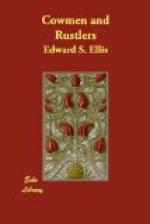The rustlers grew more daring as their numbers increased, and, instead of confining their operations to the mavericks, began altering brands. Not only that, but they were often bold enough to leave the old brand and burn a new one and forge a bill of sale.
The rustlers were generally the owners of small ranches, or cowboys who had a few head of cattle on the range or running with some rancher’s stock. The Association made a rule that no cow outfit should employ a cowman that had been guilty of branding a maverick, or of helping the rustlers, or of working with or for them. A blacklist was kept of such cowmen, with the result that a good many were unable to get employment from the Association outfits and were compelled to become rustlers themselves.
The association of rustlers became desperate because of the serious check given them by the Live Stock Association, which placed its inspectors at all the cattle-markets, Omaha, Chicago, St. Louis, Kansas City and St. Paul. Every shipment of cattle was closely inspected, and if it came from a rustler he was obliged to prove his title to each steer, or they were confiscated and the proceeds sent to the owner of the brand. Sometimes a legal proof of ownership would not be accepted, for the owners were determined to stamp out the rustling business.
Deprived by this means of a market for their hoof cattle, the rustlers were compelled to butcher their cattle or drive to Montana. The latter recourse was not only difficult and dangerous, but there was no certainty of a market when accomplished, as the Live Stock Association kept a vigilant watch on all Wyoming cattle.
The other scheme was unsatisfactory, but it was all that was left to the rustlers. They employed a number of butchers at Buffalo to do their killing for them, but even then they were not sure of always getting their meat marketed.
In the summer of 1891 the rustlers ran waggons openly on all the three great round-ups, and worked the round-up just as if they were a regular Association outfit. They also gathered in all the mavericks, and no one dared interfere.
It should be added that no more dangerous set of men can be found anywhere than the Wyoming rustlers. No living being excels them in horsemanship. The bucking pony is as a child in their hands. There is not one among them who cannot rope, throw, tie and brand a steer single-handed. They include the best riders and the best shots in the cattle business. They do not know what fear is, and in the year named became strong enough to elect one of their own number sheriff.
CHAPTER VII.
The warning.
The full moon was shining on the second night succeeding the conflict which Budd Hankinson described between the rustlers and the cowmen of Whitney’s ranch. The man that had fallen was laid away in a grave back of the house, and mother, son and daughter mourned him with a sorrow that was soothed by the consciousness that he had been a good husband and father in every sense of the word.




